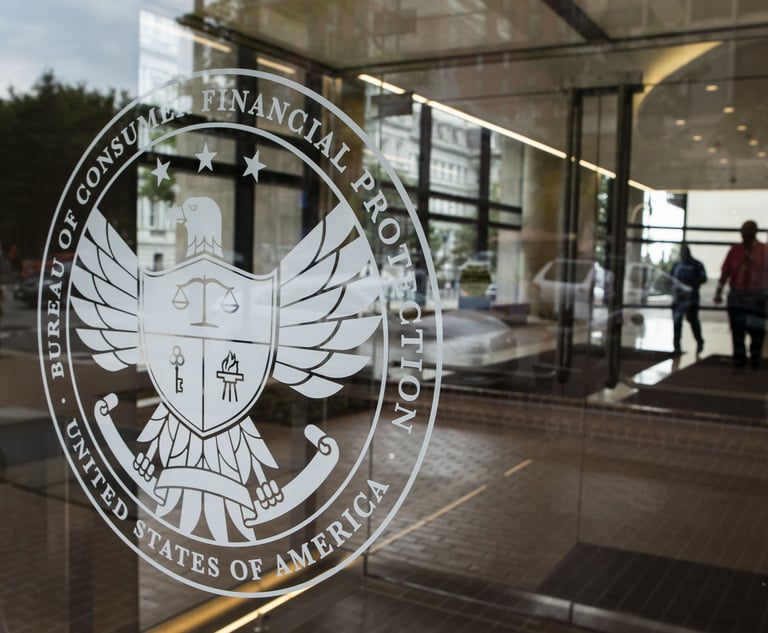Online Shopping Spikes Malware Infections: Is the Worst Yet to Come?
Even though malware infections spiked after the first weekend of online holiday shopping, the biggest spike may be yet to come. Last year the biggest…
December 27, 2017 at 12:27 PM
4 minute read
The original version of this story was published on Law.com

Even though malware infections spiked after the first weekend of online holiday shopping, the biggest spike may be yet to come. Last year the biggest day for malware infections during the holiday shopping season didn't come until the middle of December.
Computer malware infections jumped from Black Friday through Cyber Monday, according to data released by Enigma Software Group, makers of the SpyHunter anti-malware software. In fact, the research so far nationally has revealed a 123.65 percent spike; last year infections over the holiday shopping weekend jumped 106 percent; and North Carolina had the largest spike in infections with a whopping 316 percent increase.
“We believe malware makers are taking advantage of people's online habits to trick them into clicking on links that will cause infections,” said Enigma spokesperson Ryan Gerding. “Sophisticated phishing attacks appear to be particularly strong this season.”
Gerding sat down with Inside Counsel to discuss why malware infections spiked after the first weekend of online holiday shopping season. According to him, malware infections spiked after the first weekend for two key reasons: First, there was simply more online traffic. And when more people are online, there will be more infections, and second, some malware makers are specifically targeting people with attacks that take advantage of the rise in online shopping during the holidays.
“The bad guys are sending out emails that look like they are from legitimate online retailers,” he explained. “Those emails have messages aimed at trying to get people to click on a link in the email. Malware makers know that at this time of year, people may be more likely to click on an email related to online shopping because they're doing more online shopping than normal.”
In the past couple of years, it has been found that the days with the highest number of infections typically fall later in the holiday shopping season. Last year it was Dec. 14, and this year, the busiest day for infections was Dec. 13.
“It's impossible to know exactly what tactics each bad guy took advantage of for each infection on each day,” he said. “But in terms of holiday shopping activity, the middle of the holiday shopping season is when folks may be most likely to expect messages regarding shipping and delivery of items they bought early in the shopping season. So, they may be even more likely to accidentally click on something that looks legitimate.”
Today, malware makers will employ whatever tactic is at their disposal to get people to click on links that will lead to infections. Per Gerding, any time they can take advantage of your normal online activity, they will. During the holiday season that means sending fake emails that look like they are coming from online retailers. After the first of the year, they will send fake messages that look like they are updates on income tax filings because they know a lot of people might be expecting to get notices/updates/emails about their taxes at that time of year.
So, why are sophisticated phishing attacks appearing to be particularly strong this season versus in the past?
Gerding said, “We think it's mostly just a matter of evolution. The crooks realize that sending spam emails with poor graphics and typos aren't fooling anyone any more. They have to take the time to create a fake email that looks legitimate.”
Amanda G. Ciccatelli is a Freelance Journalist for Corporate Counsel and InsideCounsel, where she covers intellectual property, legal technology, patent litigation, cybersecurity, innovation, and more.
This content has been archived. It is available through our partners, LexisNexis® and Bloomberg Law.
To view this content, please continue to their sites.
Not a Lexis Subscriber?
Subscribe Now
Not a Bloomberg Law Subscriber?
Subscribe Now
NOT FOR REPRINT
© 2024 ALM Global, LLC, All Rights Reserved. Request academic re-use from www.copyright.com. All other uses, submit a request to [email protected]. For more information visit Asset & Logo Licensing.
You Might Like
View All
As AI-Generated Fraud Rises, Financial Companies Face a Long Cybersecurity Battle

AI Adoption, Data Center Building Boom Opening More Doors for Cybercriminals, Many of Them Teenagers


Legal Departments’ Lack of Third-Party Oversight Leaving Small, Midsized Banks Exposed
4 minute readTrending Stories
- 1Call for Nominations: Elite Trial Lawyers 2025
- 2Senate Judiciary Dems Release Report on Supreme Court Ethics
- 3Senate Confirms Last 2 of Biden's California Judicial Nominees
- 4Morrison & Foerster Doles Out Year-End and Special Bonuses, Raises Base Compensation for Associates
- 5Tom Girardi to Surrender to Federal Authorities on Jan. 7
Who Got The Work
Michael G. Bongiorno, Andrew Scott Dulberg and Elizabeth E. Driscoll from Wilmer Cutler Pickering Hale and Dorr have stepped in to represent Symbotic Inc., an A.I.-enabled technology platform that focuses on increasing supply chain efficiency, and other defendants in a pending shareholder derivative lawsuit. The case, filed Oct. 2 in Massachusetts District Court by the Brown Law Firm on behalf of Stephen Austen, accuses certain officers and directors of misleading investors in regard to Symbotic's potential for margin growth by failing to disclose that the company was not equipped to timely deploy its systems or manage expenses through project delays. The case, assigned to U.S. District Judge Nathaniel M. Gorton, is 1:24-cv-12522, Austen v. Cohen et al.
Who Got The Work
Edmund Polubinski and Marie Killmond of Davis Polk & Wardwell have entered appearances for data platform software development company MongoDB and other defendants in a pending shareholder derivative lawsuit. The action, filed Oct. 7 in New York Southern District Court by the Brown Law Firm, accuses the company's directors and/or officers of falsely expressing confidence in the company’s restructuring of its sales incentive plan and downplaying the severity of decreases in its upfront commitments. The case is 1:24-cv-07594, Roy v. Ittycheria et al.
Who Got The Work
Amy O. Bruchs and Kurt F. Ellison of Michael Best & Friedrich have entered appearances for Epic Systems Corp. in a pending employment discrimination lawsuit. The suit was filed Sept. 7 in Wisconsin Western District Court by Levine Eisberner LLC and Siri & Glimstad on behalf of a project manager who claims that he was wrongfully terminated after applying for a religious exemption to the defendant's COVID-19 vaccine mandate. The case, assigned to U.S. Magistrate Judge Anita Marie Boor, is 3:24-cv-00630, Secker, Nathan v. Epic Systems Corporation.
Who Got The Work
David X. Sullivan, Thomas J. Finn and Gregory A. Hall from McCarter & English have entered appearances for Sunrun Installation Services in a pending civil rights lawsuit. The complaint was filed Sept. 4 in Connecticut District Court by attorney Robert M. Berke on behalf of former employee George Edward Steins, who was arrested and charged with employing an unregistered home improvement salesperson. The complaint alleges that had Sunrun informed the Connecticut Department of Consumer Protection that the plaintiff's employment had ended in 2017 and that he no longer held Sunrun's home improvement contractor license, he would not have been hit with charges, which were dismissed in May 2024. The case, assigned to U.S. District Judge Jeffrey A. Meyer, is 3:24-cv-01423, Steins v. Sunrun, Inc. et al.
Who Got The Work
Greenberg Traurig shareholder Joshua L. Raskin has entered an appearance for boohoo.com UK Ltd. in a pending patent infringement lawsuit. The suit, filed Sept. 3 in Texas Eastern District Court by Rozier Hardt McDonough on behalf of Alto Dynamics, asserts five patents related to an online shopping platform. The case, assigned to U.S. District Judge Rodney Gilstrap, is 2:24-cv-00719, Alto Dynamics, LLC v. boohoo.com UK Limited.
Featured Firms
Law Offices of Gary Martin Hays & Associates, P.C.
(470) 294-1674
Law Offices of Mark E. Salomone
(857) 444-6468
Smith & Hassler
(713) 739-1250






